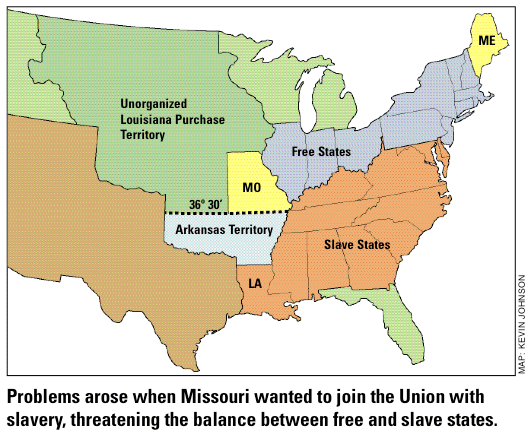
When President Thomas Jefferson purchased 828,000 acres of heartland from Napoleon of France for a little more than $11 million in 1803, he was overjoyed with the prospect of securing the vital Mississippi River and the port of New Orleans for America’s interests. But with all the good that the Louisiana Purchase brought to the United States, it also presented the growing country with a difficult and painful question: Should the states created out of that land be slave or free?
Louisiana had been carved out and accepted as a slave state in 1812, but no other territory had petitioned Congress for statehood out of the purchase lands until Missouri did so in 1818, also wanting to enter the Union as a slave state. That request threatened to unsettle a delicate balance of 11 slave and 11 free states, a balance both sides found necessary for maintaining equal representation in the Senate.
The fledgling abolitionist movement saw a chance to bring its cause to the foreground, and the issue of slavery in Missouri was thrown before the House of Representatives in February 1819 when James Tallmadge of New York proposed an amendment to ban slavery within the boundaries of the new state. Tallmadge also advocated gradual emancipation for the thousands of chattels already living there.
That amendment set off contentious debates within the House and brought the issue of slavery into the national spotlight once again, after the topic had been comparatively quiet since the late 18th century. Southerners adamantly fought the Tallmadge Amendment, protesting the imbalance of representation that having one more free than slave state would cause, as well as the unveiled threat on the institution so critical to the plantation economy.
On the other side of the aisle, most Northern representatives were not abolitionists and cared little for slaves as people, but supported Tallmadge because they believed slavery posed a threat to the farm-and-industry economic model just beginning to take hold above the Mason-Dixon line. In short, they didn’t want large plantations taking all the land from free husbandmen and their families.
In mid-February 1819, the Tallmadge Amendment passed the House by a vote of 82 to 78, but both the slavery ban and the emancipation proposals were defeated in the Senate. The issue remained at an impasse until December when Maine and Henry Clay, the Speaker of the House from Kentucky who owned slaves but had famously proclaimed that he was an American first and a Southerner second, entered the debate. Maine, up to that time a part of Massachusetts, wanted to enter as a free state, and Clay decreed that could not occur unless Missouri came in with slavery.
In February 1820, Illinois Senator Jesse B.Thomas suggested a proposal that would eventually be called the Missouri Compromise: Maine would enter as a free state, Missouri would come in with slaves, but no slavery would be permitted in other states developed out of the Louisiana Purchase north of 36 degrees 30 minutes latitude, Missouri’s southern boundary. The Thomas proposal was accepted in the Senate but defeated in the House, and ardent debate along sectional lines resumed in Congress.
Clay stepped into the fray again and used his considerable influence and power as House speaker to work with both his Northern and Southern colleagues and have them accept Thomas’ compromise as a resolution to the situation. In early March, Congress finally agreed on what they called the Missouri Compromise.
Many congressmen remained shaken by the controversy. Slavery had once again proved to be an issue that divided the nation along sectional lines. Southerners had been thrown on the defensive to justify their “peculiar institution,” Northerners had fumed that “slave power” was trying to take up all the land, and abolitionists such as Congressman Arthur Livermore of New Hampshire wondered “how long will the desire for wealth render us blind to the sin of holding…our fellow men in chains?”
he Missouri Compromise would prove to be only a temporary solution to the growing slavery crisis. For 25 years the situation regarding territorial settlement remained relatively calm. But when the Mexican War in 1846-48 brought more land under the United States’ control, the nettlesome issue flared up again. Once more, Henry Clay had to step in to hammer out a compromise—and once more it would be only temporary, as more and more crises over slavery erupted.
As the early debates over Missouri’s admission raged, perhaps no one was more unsettled than the man who had purchased all that cheap land west of the Mississippi River. In 1820 Thomas Jefferson wrote to a friend that the fight over slavery in Missouri “like a fire bell in the night, awakened me and filled me with terror.” Jefferson would die in 1826, but the fire bells over slavery had just begun to toll.




